Designing Adhered Masonry Veneer
Properly Specified Masonry Veneer Wall Components
Following are more details about the components typical of an adhered veneer wall designed to meet today’s demand for high-performance, sustainable buildings. Specifics of weep screed sizes, WRB characteristics, insulation type and thickness, and mortar, veneer and fastener types will vary with climate and local codes.
Weep Screed
Weep screed is typically galvanized metal or plastic. The galvanized weep screed must be a minimum 26 gauge or 0.018 inches thick, and the plastic weep screed must be a minimum 0.050 inches thick. Both include a nailing strip that must extend a minimum of 3.5 inches up the wall. On wood or steel stud walls, the weep screed is attached to the bottom of the wall on top of the sheathing. On CMU walls, the weep screed is attached to the CMU. When a sheet type WRB is used, the WRB must lap over the top of the weep screed nailing flange and extend to the point where the screed angles away from the wall. When a liquid WRB is used, the weep screed is installed over the top of the WRB and should be sealed along the top of the nail flange and around any penetrations. These steps prevent moisture from wicking into the base plate of the framing—a very important consideration since moisture in these areas can create rust or rot, which may be concealed from view after construction.
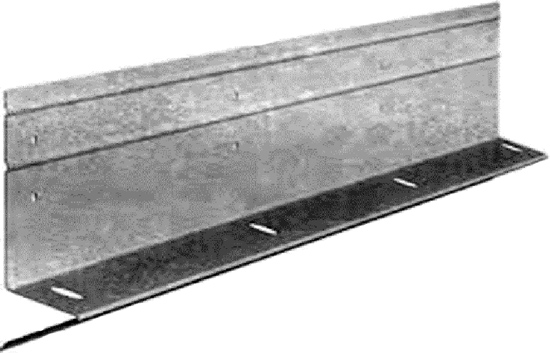
Photo courtesy of Mortar Net Solutions
Typical metal weep screed
On projects with no RI, the screed is attached directly on top of the sheathing or CMU. On projects with RI, the screed is attached on top of the insulation. Both designs require fasteners that penetrate into structural members, CMU, or concrete substrate at least ¾ inch, and steel structural members at least 3/8 inch. The weep screed also provides a clean edge to transition the base of the veneer from the rest of the structure. A weep screed is especially important when using a drainage mesh because it allows water that runs down the mesh to easily exit from behind the wall and for air to move in and out of the mesh. Many building code officials have recently become more stringent in the enforcement of weep screed standards, so be sure to check with local code officials when detailing the screed.
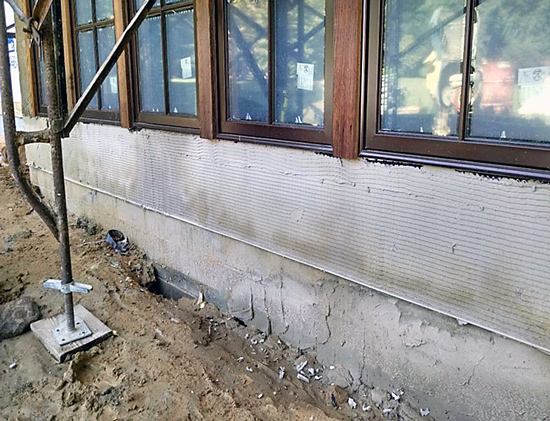
Photo courtesy of Mortar Net Solutions
Weep screed must be a minimum 4 inches above finish grade.
The weep screed must be placed a minimum of 4 inches above finish grade and 2 inches above a roof line. It is very important that water sprinklers, gutter discharge, or water splash of any sort be prevented from hitting the base of the veneer to prevent staining and freeze damage.
Weather Resistant Barrier
In traditional adhered veneer systems, two layers of WRB are the only defense against water that penetrates the veneer. It is very important for the WRB to remain undamaged during construction. If adhered masonry veneer is saturated and cannot dry quickly, the water will wick through damaged WRB into the sheathing, insulation, and framing of the house. This condition frequently results in wall failure, often before the problem causing the failure becomes apparent and after the point where it can be easily repaired. However, if a drainage mesh is installed between the wire lath and WRB, the saturated veneer is not in contact with the WRB, the wall can breathe and drain much more efficiently, and moisture is much less likely to penetrate the WRB and be absorbed into the structure.
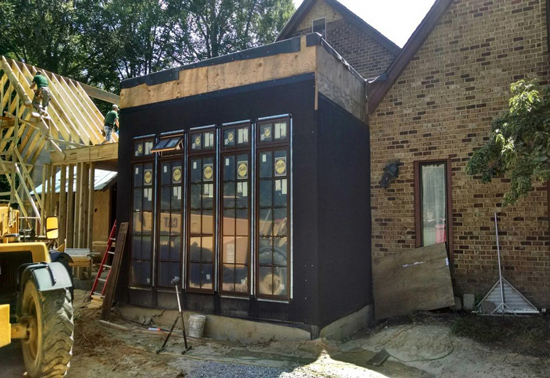
Photo courtesy of Mortar Net Solutions
WRB at building outside corner
When the WRB terminates at inside and outside corners, it must extend a minimum of 16 inches on either side of the corners for both layers. A WRB is typically installed with only enough staples or roofing nails to hold the material in place until the metal lath is installed to minimize penetrations. WRBs will repel water for short periods of time, but are not considered waterproof, so proper construction scheduling is very important.
Continuous Rigid Insulation
Continuous rigid insulation (RI) has become increasingly popular with adhered masonry veneers because it provides far better insulating performance than batt insulation between studs. For example, steel studs can act as thermal bridges that reduce the effective insulating performance of batts by as much as 50 perecent, but RI forms a continuous thermal barrier with no thermal bridges other than the fasteners. For best performance, the insulation must be fastened to the substrate with self-sealing screws and washers, which prevent moisture and air movement through the fastener penetrations, thus reducing thermal transfer. Some types of RI may be installed with taped seams to provide even greater resistance to air and moisture movement, and some of these RI types act as WRBs as well as insulation.
Lath
Lath is offered in three different designations that describe the lath’s weight per square yard: 1.75 pounds for interior applications, and 2.5 pounds and 3.4 pounds for exterior applications. Self-furring metal lath includes ¼-inch-deep dimples spaced evenly throughout the material that hold the lath sheet away from the substrate and WRB or drainage mesh, and allow full lath encapsulation by the base mortar coat.
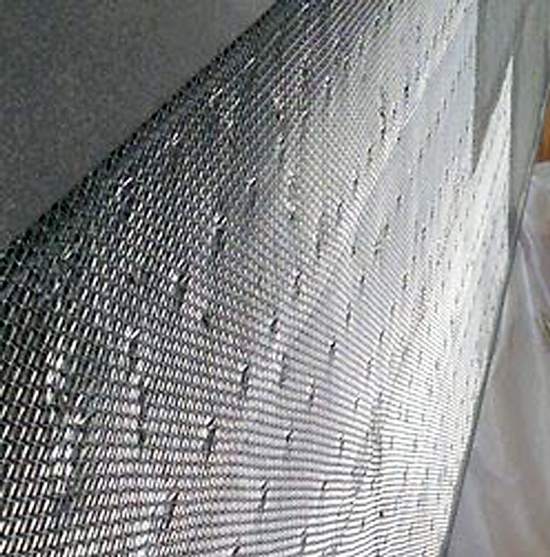
Photo courtesy of Mortar Net Solutions
Self-furring lath
Fastening
ASTM International requires that lath be fastened at intervals of not less than 7 inches on center, and the Uniform Building Code (UBC) requires a minimum spacing of 6 inches on center on all structural members. Lath can be terminated at an inside corner but must extend at least 12 inches in both directions on either side of an outside corner.
Spacing the fasteners too far apart or failing to fasten to the structural members are the most common causes of adhered masonry veneer fastener failure. Fasteners that penetrate the sheathing but not a structural member will almost certainly work loose and may allow moisture to penetrate through the WRB, so it is highly recommended to specify that all fasteners must penetrate a structural member.
Metal lath fastened over RI that is ½ inch thick or less may be attached with a non-engineered fastening system, but designs with RI thicker than ½ inch require an engineered lath anchoring system. Fastener manufacturers can provide guidance, and a guide from the Foam Sheathing Coalition™ for attaching exterior wallcoverings though foam sheathing can be found at www.hunterxci.com/images/technical_docs/FSC_Guide_attachingtoXci_SS.pdf.
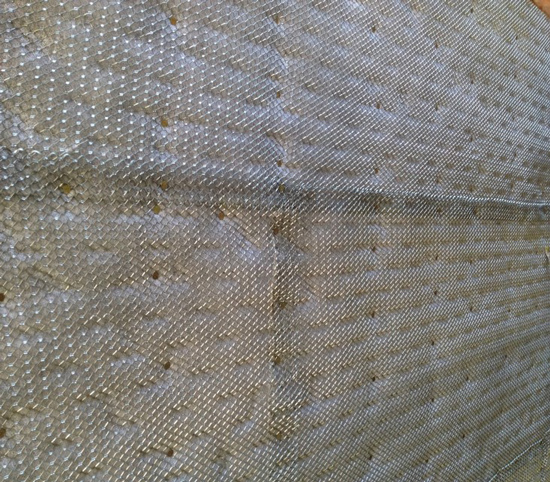
Photo courtesy of Mortar Net Solutions
Self-furring metal lath properly fastened to structural members
Allowable non-corrosive or corrosion-resistant fasteners for wood framing include staples, roofing nails, and screws. The minimum embedment into a structural member is ¾ inch, but a minimum of 1 inch is a good practice to follow because it provides extra fastening security and helps ensure that fasteners will sufficiently penetrate warped structural members. Steel studs require self-tapping screw or hex head anchors with a neoprene washer or 1¼-inch galvanized washer attached. For concrete or CMUs, powder actuated fasteners or concrete masonry screws may be used.
Integrated Lath/Drainage Systems
Factory-assembled lath/drainage systems are new, but use materials and design principals that have been a part of the industry for decades. The newest system combines 2.5-pound lath with a ¼-inch-thick drainage mesh so they can be installed together in one pass. A 3.4-pound self-furring lath and 10-millimeter mesh are available as options. It has a built-in lath overlap on two sides that conforms with ASTM Specification C-847, so the drainage mesh is always aligned properly to produce a continuous drainage plane, and the lath overlap is consistent. Because the drainage mesh acts as a mortar break, it usually requires only one layer of WRB.
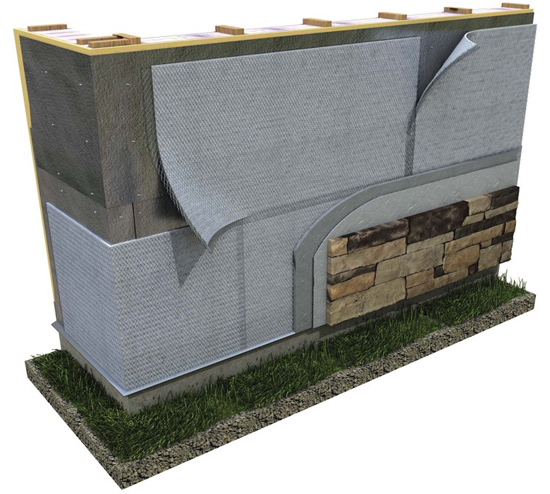
Image courtesy of Mortar Net Solutions
Factory-assembled metal lath/drainage mesh system
The other lath system is a lath and paper combination for use in temporarily protecting stud cavity and sheathing walls during and after construction. However, this product does not include the airspace that is provided with the factory-assembled lath/drainage system.
Installation
While installation is obviously not part of the designer’s job, an overview of good installation practices can help the designer know what to look for during site visits to be sure the veneer is installed properly. The WRB and weep screed must have no loose edges or penetrations other than fasteners before the RI, lath, or drainage mesh and lath are installed. The RI (if specified) and lath must be attached with the proper fasteners at the proper spacings and only into the structural members.
When flashing systems are used with adhered masonry veneer, follow standard flashing techniques. There are a variety of flashing systems, materials, and techniques available, and a detailed discussion of them is beyond the scope of this course.
Mortar must be applied in a way that allows it to cure completely to yield maximum strength. Mortar “cures” rather than “dries,” which means it forms interlocking crystals as it hardens that provide the material’s strength. Efficient building production requires that the mortar cure as quickly as possible while keeping in mind that if it cures too quickly, it will not have time to form a complete crystalline matrix and its strength will be compromised. To help mortar cure completely, lath that has been in direct sunlight and is hot to the touch should be cooled with a light water spray before mortar application, but the wall should not be wet. On windy days, the base coat should be covered with plastic to slow evaporation, and on hot days, the base coat must be misted during curing. In cold weather, the mortar must be protected from freezing.
The base coat is applied over the lath and must be applied evenly. An uneven base coat, in which the mortar has high and low spots, can create air pockets behind the veneer in which water can accumulate and cause freeze/thaw damage.
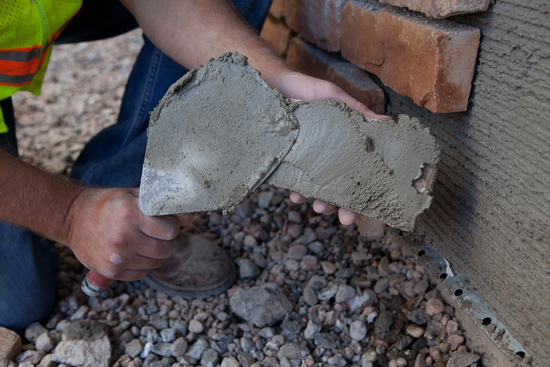
Photo courtesy of Mortar Net Solutions
Properly buttered veneer unit
The veneer can be installed when the base coat is “green” or when it’s fully set. Installers “butter” or apply a coat of mortar to the entire back of the veneer units, then push, twist, and hold each unit for a few seconds to allow full adhesion. Capillary action between the wet and dry mortar creates a very strong bond that is almost instantaneous, and the mortar also produces a chemical bond between the two coats as it cures.
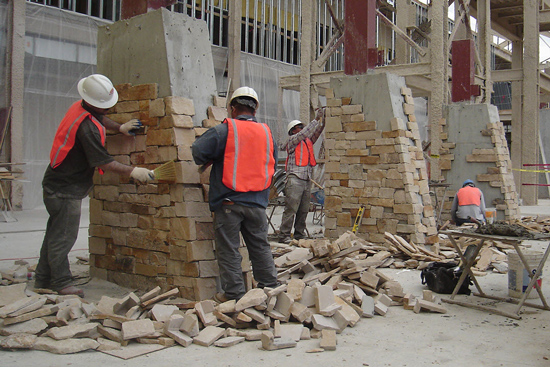
Photo courtesy of Mortar Net Solutions
Mix multiple boxes of veneer units before installation to minimize color variances.
It is highly recommended that installers mix several boxes of veneer units together before installation to minimize color variances in the veneer. If a modular product has not been specified, this step also allows the installer to become familiar with the various unit sizes in each box and to plan how to apply the units in a pleasing pattern. Cut and smaller-sized units will be less visible at the weep screed or a few courses up within the pattern of the bond.
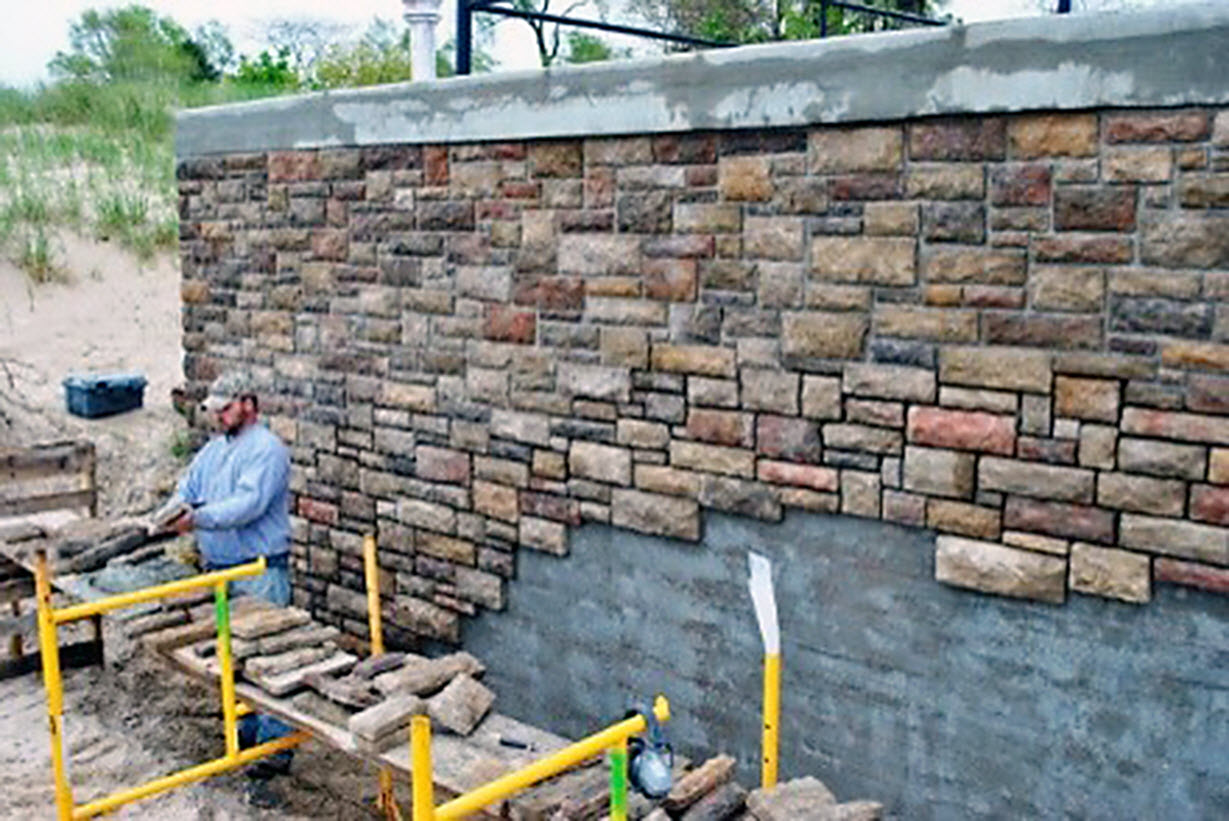
Photo courtesy of Mortar Net Solutions
Preferred veneer unit installation method is from top down.
Installing units from top to bottom is the preferred installation method because it reduces the mortar droppings on finished work. Mortar droppings on veneer units should not be removed until the mortar has dried, at which point they will easily pop off using a tuck pointer and a brush. Trying to clean mortar before it dries simply smears the mortar and makes it more difficult to remove.
With cultured stone veneers, masonry cleaners, wire brushes, or pressure washers should not be used, as they will remove the texture that gives the material its stone-like appearance. Light duty cleaners can be used for thin brick and natural thin stone veneers. It’s very important for installers to turn scaffolding walk boards on edge each night, as a rain shower can spatter wet droppings or residual dust on the boards onto the wall, creating damage that only unit replacement can fix. Once the units are attached to the wall and initial mortar set has occurred, installers grout the joints using a tuck pointer and hawk or a grout bag.









